No. 1. Westside Lowlands Conifer-Hardwood Forest
Christopher B. Chappell and Jimmy Kagan
Geographic Distribution. This forest habitat occurs throughout
low-elevation western Washington, except on extremely dry or wet sites. In
Oregon it occurs on the western slopes of the Cascades, around the margins of
the Willamette Valley, in the Coast Range, and along the outer coast. The global
distribution extends from southeastern Alaska south to southwestern Oregon.
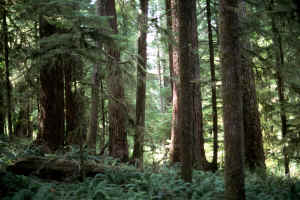 Physical Setting. Climate is relatively mild and moist to wet. Mean
annual precipitation is mostly 35-100 inches (90-254 cm), but can vary locally.
Snowfall ranges from rare to regular, but is transitory. Summers are relatively
dry. Summer fog is a major factor on the outer coast in the Sitka spruce zone.
Elevation ranges from sea level to a maximum of about 2,000 ft (610 m) in much
of northern Washington and 3,500 ft (1,067 m) in central Oregon. Soils and
geology are very diverse. Topography ranges from relatively flat glacial till
plains to steep mountainous terrain.
Physical Setting. Climate is relatively mild and moist to wet. Mean
annual precipitation is mostly 35-100 inches (90-254 cm), but can vary locally.
Snowfall ranges from rare to regular, but is transitory. Summers are relatively
dry. Summer fog is a major factor on the outer coast in the Sitka spruce zone.
Elevation ranges from sea level to a maximum of about 2,000 ft (610 m) in much
of northern Washington and 3,500 ft (1,067 m) in central Oregon. Soils and
geology are very diverse. Topography ranges from relatively flat glacial till
plains to steep mountainous terrain.
Landscape Setting. This is the most extensive habitat in the lowlands on
the westside of the Cascades, except in southwestern Oregon, and forms the
matrix within which other habitats occur as patches, especially Westside
Riparian-Wetlands and less commonly Herbaceous Wetlands or Open Water. It also
occurs adjacent to or in a mosaic with Urban and Mixed Environs (hereafter
Urban) or Agriculture, Pasture and Mixed Environs (hereafter Agriculture) habitats. In the
driest areas, it occurs adjacent to or in a mosaic with Westside Oak and Dry
Douglas-fir Forest and Woodlands. Bordering this habitat at upper elevations is
Montane Mixed Conifer Forest. Along the coastline, it often occurs adjacent to
Coastal Dunes and Beaches. In southwestern Oregon, it may border Southwest
Oregon Mixed Conifer-Hardwood Forest. The primary land use for this habitat is
forestry.
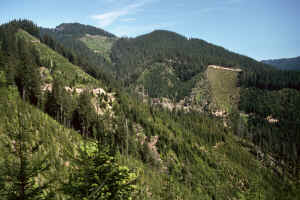 Structure. This habitat is forest, or rarely woodland, dominated by
evergreen conifers, deciduous broadleaf trees, or both. Late seral stands
typically have an abundance of large (>164 ft [50 m] tall) coniferous trees,
a multi-layered canopy structure, large snags, and many large logs on the
ground. Early seral stands typically have smaller trees, single-storied
canopies, and may be dominated by conifers, broadleaf trees, or both. Coarse
woody debris is abundant in early seral stands after natural disturbances but
much less so after clearcutting. Forest understories are structurally diverse:
evergreen shrubs tend to dominate on nutrient-poor or drier sites; deciduous
shrubs, ferns, and/or forbs tend to dominate on relatively nutrient-rich or
moist sites. Shrubs may be low (1.6 ft [0.5 m] tall), medium-tall (3.3-6.6 ft
[1-2 m]), or tall (6.6-13.1 ft [2-4 m]). Almost all structural stages are
represented in the successional sequence within this habitat. Mosses are often a
major ground cover. Lichens are abundant in the canopy of old stands.
Structure. This habitat is forest, or rarely woodland, dominated by
evergreen conifers, deciduous broadleaf trees, or both. Late seral stands
typically have an abundance of large (>164 ft [50 m] tall) coniferous trees,
a multi-layered canopy structure, large snags, and many large logs on the
ground. Early seral stands typically have smaller trees, single-storied
canopies, and may be dominated by conifers, broadleaf trees, or both. Coarse
woody debris is abundant in early seral stands after natural disturbances but
much less so after clearcutting. Forest understories are structurally diverse:
evergreen shrubs tend to dominate on nutrient-poor or drier sites; deciduous
shrubs, ferns, and/or forbs tend to dominate on relatively nutrient-rich or
moist sites. Shrubs may be low (1.6 ft [0.5 m] tall), medium-tall (3.3-6.6 ft
[1-2 m]), or tall (6.6-13.1 ft [2-4 m]). Almost all structural stages are
represented in the successional sequence within this habitat. Mosses are often a
major ground cover. Lichens are abundant in the canopy of old stands.
Composition. Western hemlock (Tsuga heterophylla) and Douglas-fir
(Pseudotsuga menziesii) are the most characteristic species and 1 or both
are typically present. Most stands are dominated by 1 or more of the following:
Douglas-fir, western hemlock, western redcedar (Thuja plicata), Sitka
spruce (Picea sitchensis), red alder (Alnus rubra), or bigleaf
maple (Acer macrophyllum). Trees of local importance that may be dominant
include Port-Orford cedar (Chamaecyparis lawsoniana) in the south, shore
pine (Pinus contorta var. contorta) on stabilized dunes, and grand fir
(Abies grandis) in drier climates. Western white pine (Pinus monticola) is
frequent but subordinate in importance through much of this habitat. Pacific
silver fir (Abies amabilis) is largely absent except on the wettest
low-elevation portion of the western Olympic Peninsula, where it is common and
sometimes co-dominant. Common small subcanopy trees are cascara buckthorn (Rhamnus
purshiana) in more moist climates and Pacific yew (Taxus brevifolia)
in somewhat drier climates or sites.
Sitka spruce is found as a major species only in the outer coastal area at
low elevations where summer fog is a significant factor. Bigleaf maple is most
abundant in the Puget Lowland, around the Willamette Valley, and in the central
Oregon Cascades, but occurs elsewhere also. Douglas-fir is absent to uncommon as
a native species in the very wet maritime outer coastal area of Washington,
including the coastal plain on the west side of the Olympic Peninsula. However,
it has been extensively planted in that area. Port-Orford cedar occurs only in
southern Oregon. Paper birch (Betula papyrifera) occurs as a co-dominant only in Whatcom County,
Washington. Grand fir occurs as an occasional co-dominant only in the Puget
Lowland and Willamette Valley.
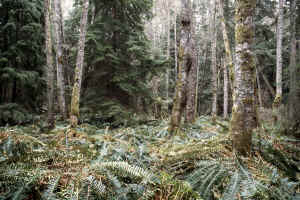 Dominant or co-dominant understory shrub species of more than local
importance include salal (Gaultheria shallon), dwarf Oregongrape (Mahonia
nervosa), vine maple (Acer circinatum), Pacific rhododendron (Rhododendron
macrophyllum), salmonberry (Rubus spectabilis), trailing blackberry (R.
ursinus), red elderberry (Sambucus racemosa), fools huckleberry (Menziesia
ferruginea), beargrass (Xerophyllum tenax), oval-leaf huckleberry (Vaccinium ovalifolium),
evergreen huckleberry (V. ovatum), and red huckleberry (V.
parvifolium). Salal and rhododendron are particularly associated with low
nutrient or relatively dry sites.
Dominant or co-dominant understory shrub species of more than local
importance include salal (Gaultheria shallon), dwarf Oregongrape (Mahonia
nervosa), vine maple (Acer circinatum), Pacific rhododendron (Rhododendron
macrophyllum), salmonberry (Rubus spectabilis), trailing blackberry (R.
ursinus), red elderberry (Sambucus racemosa), fools huckleberry (Menziesia
ferruginea), beargrass (Xerophyllum tenax), oval-leaf huckleberry (Vaccinium ovalifolium),
evergreen huckleberry (V. ovatum), and red huckleberry (V.
parvifolium). Salal and rhododendron are particularly associated with low
nutrient or relatively dry sites.
Swordfern (Polystichum munitum) is the most common herbaceous species
and is often dominant on nitrogen-rich or moist sites. Other forbs and ferns
that frequently dominate the understory are Oregon oxalis (Oxalis oregana),
deerfern (Blechnum spicant), bracken fern (Pteridium aquilinum),
vanillaleaf (Achlys triphylla), twinflower (Linnaea borealis),
false lily-of-the-valley (Maianthemum dilatatum), western
springbeauty (Claytonia siberica), foamflower (Tiarella
trifoliata), inside-out flower (Vancouveria hexandra), and
common
whipplea (Whipplea modesta).
Other Classifications and Key References. This habitat includes most of
the forests and their successional seres within the Tsuga heterophylla
and Picea sitchensis zones 88. This habitat is also referred
to as Douglas-fir-western hemlock and Sitka spruce-western hemlock
forests 87, spruce-cedar-hemlock forest (Picea-Thuja-Tsuga,
No. 1) and cedar-hemlock-Douglas-fir forest (Thuja-Tsuga-Pseudotsuga,
No. 2) 136. The Oregon Gap II Project 126 and Oregon
Vegetation Landscape-Level Cover Types 127 would crosswalk with Sitka
spruce-western hemlock maritime forest, Douglas-fir-western hemlock-red cedar
forest, red alder forest, red alder-bigleaf maple forest, mixed conifer/mixed
deciduous forest, south coast mixed-deciduous forest, and coastal lodgepole
forest. The Washington Gap Vegetation map includes this vegetation as conifer
forest, mixed hardwood/conifer forest, and hardwood forest in the Sitka spruce,
western hemlock, Olympic Douglas-fir, Puget Sound Douglas-fir, Cowlitz River and
Willamette Valley zones 37. A number of other references describe
elements of this habitats 13, 25, 26, 40, 42, 66, 90, 104, 110, 111, 114, 115, 210.
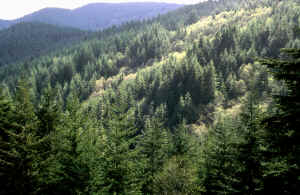 Natural Disturbance Regime. Fire is the major natural disturbance in all
but the wettest climatic area (Sitka spruce zone), where wind becomes the major
source of natural disturbance. Natural fire-return intervals generally range
from about 100 years or less in the driest areas to several hundred years
1, 115, 160. Mean fire-return interval for the western hemlock zone as a
whole is 250 years, but may vary greatly. Major natural fires are associated
with occasional extreme weather conditions 1. Fires are typically
high-severity, with few trees surviving. However, low- and moderate-severity
fires that leave partial to complete live canopies are not uncommon, especially
in drier climatic areas. Occasional major windstorms hit outer coastal forests
most intensely, where fires are rare. Severity of wind disturbance varies
greatly, with minor events being extremely frequent and major events occurring
once every few decades. Bark beetles and fungi are significant causes of
mortality that typically operate on a small scale. Landslides are another
natural disturbance that occur in some areas.
Natural Disturbance Regime. Fire is the major natural disturbance in all
but the wettest climatic area (Sitka spruce zone), where wind becomes the major
source of natural disturbance. Natural fire-return intervals generally range
from about 100 years or less in the driest areas to several hundred years
1, 115, 160. Mean fire-return interval for the western hemlock zone as a
whole is 250 years, but may vary greatly. Major natural fires are associated
with occasional extreme weather conditions 1. Fires are typically
high-severity, with few trees surviving. However, low- and moderate-severity
fires that leave partial to complete live canopies are not uncommon, especially
in drier climatic areas. Occasional major windstorms hit outer coastal forests
most intensely, where fires are rare. Severity of wind disturbance varies
greatly, with minor events being extremely frequent and major events occurring
once every few decades. Bark beetles and fungi are significant causes of
mortality that typically operate on a small scale. Landslides are another
natural disturbance that occur in some areas.
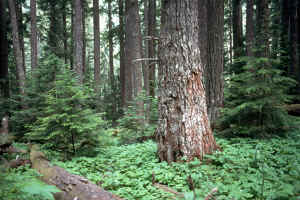 Succession and Stand Dynamics. After a severe fire or blowdown, a typical
stand will be briefly occupied by annual and perennial ruderal forbs and grasses
as well as predisturbance understory shrubs and herbs that resprout 102.
Herbaceous species generally give way to dominance by shrubs or a mixture of
shrubs and young trees within a few years. If shrubs are dense and trees did not
establish early, the site may remain as a shrubland for an indeterminate period.
Early seral tree species can be any of the potential dominants for the habitat,
depending on environment, type of disturbance, and seed source. All of these
species except the short-lived red alder are capable of persisting for at least
a few hundred years. Douglas-fir is the most common dominant after fire, but is
uncommon in the wettest zones. It is also the most fire resistant of the trees
in this habitat and survives moderate-severity fires well. After the tree canopy
closes, the understory may become sparse, corresponding with the stem-exclusion
stage 168. Eventually tree density will decrease and the understory
will begin to flourish again, typically at stand age 60-100 years. As trees grow
larger and a new generation of shade-tolerant understory trees (usually western
hemlock, less commonly western redcedar) grows up, a multi-layered canopy will
gradually develop and be well expressed by stand age 200-400 years 89.
Another fire is likely to return before the loss of shade-intolerant Douglas-fir
from the canopy at stand age 800-1,000 years, unless the stand is located in the
wet maritime zone. Throughout this habitat, western hemlock tends to increase in
importance as stand development proceeds. Coarse woody debris peaks in abundance
in the first 50 years after a fire and is least abundant at about stand age
100-200 years 193.
Succession and Stand Dynamics. After a severe fire or blowdown, a typical
stand will be briefly occupied by annual and perennial ruderal forbs and grasses
as well as predisturbance understory shrubs and herbs that resprout 102.
Herbaceous species generally give way to dominance by shrubs or a mixture of
shrubs and young trees within a few years. If shrubs are dense and trees did not
establish early, the site may remain as a shrubland for an indeterminate period.
Early seral tree species can be any of the potential dominants for the habitat,
depending on environment, type of disturbance, and seed source. All of these
species except the short-lived red alder are capable of persisting for at least
a few hundred years. Douglas-fir is the most common dominant after fire, but is
uncommon in the wettest zones. It is also the most fire resistant of the trees
in this habitat and survives moderate-severity fires well. After the tree canopy
closes, the understory may become sparse, corresponding with the stem-exclusion
stage 168. Eventually tree density will decrease and the understory
will begin to flourish again, typically at stand age 60-100 years. As trees grow
larger and a new generation of shade-tolerant understory trees (usually western
hemlock, less commonly western redcedar) grows up, a multi-layered canopy will
gradually develop and be well expressed by stand age 200-400 years 89.
Another fire is likely to return before the loss of shade-intolerant Douglas-fir
from the canopy at stand age 800-1,000 years, unless the stand is located in the
wet maritime zone. Throughout this habitat, western hemlock tends to increase in
importance as stand development proceeds. Coarse woody debris peaks in abundance
in the first 50 years after a fire and is least abundant at about stand age
100-200 years 193.
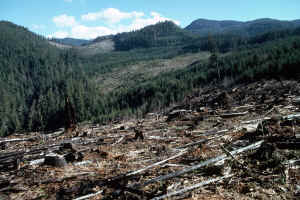 Effects of Management and Anthropogenic Impacts. Red alder is more
successful after typical logging disturbance than after fire alone on moist,
nutrient-rich sites, perhaps because of the speciesí ability to establish
abundantly on scarified soils 100. Alder is much more common now
because of large-scale logging activities 87. Alder grows more
quickly in height early in succession than the conifers, thereby prompting many
forest managers to apply herbicides for alder control. If alder is allowed to
grow and dominate early successional stands, it will decline in importance after
about 70 years and die out completely by age 100. Often there are suppressed
conifers in the subcanopy that potentially can respond to the death of the alder
canopy. However, salmonberry sometimes forms a dense shrub layer under the
alder, which can exclude conifer regeneration 88. Salmonberry
responds positively to soil disturbance, such as that associated with logging 19.
Bigleaf maple sprouts readily after logging and is therefore well adapted to
increase after disturbance as well. Clearcut logging and plantation forestry
have resulted in less diverse tree canopies, and have focused mainly on
Douglas-fir, with reductions in coarse woody debris over natural levels, a shortened
stand initiation phase, and succession truncated well before late-seral
characteristics are expressed. Douglas-fir has been almost universally planted,
even in wet coastal areas of Washington, where it is rare in natural stands.
Effects of Management and Anthropogenic Impacts. Red alder is more
successful after typical logging disturbance than after fire alone on moist,
nutrient-rich sites, perhaps because of the speciesí ability to establish
abundantly on scarified soils 100. Alder is much more common now
because of large-scale logging activities 87. Alder grows more
quickly in height early in succession than the conifers, thereby prompting many
forest managers to apply herbicides for alder control. If alder is allowed to
grow and dominate early successional stands, it will decline in importance after
about 70 years and die out completely by age 100. Often there are suppressed
conifers in the subcanopy that potentially can respond to the death of the alder
canopy. However, salmonberry sometimes forms a dense shrub layer under the
alder, which can exclude conifer regeneration 88. Salmonberry
responds positively to soil disturbance, such as that associated with logging 19.
Bigleaf maple sprouts readily after logging and is therefore well adapted to
increase after disturbance as well. Clearcut logging and plantation forestry
have resulted in less diverse tree canopies, and have focused mainly on
Douglas-fir, with reductions in coarse woody debris over natural levels, a shortened
stand initiation phase, and succession truncated well before late-seral
characteristics are expressed. Douglas-fir has been almost universally planted,
even in wet coastal areas of Washington, where it is rare in natural stands.
Status and Trends. Extremely large areas of this habitat remain. Some
loss has occurred, primarily to development in the Puget Lowland. Condition of
what remains has been degraded by industrial forest practices at both the stand
and landscape scale. Most of the habitat is probably now in Douglas-fir
plantations. Only a fraction of the original old-growth forest remains, mostly
in national forests in the Cascade and Olympic mountains. Areal extent continues
to be reduced gradually, especially in the Puget Lowland. An increase in
alternative silviculture practices may be improving structural and species
diversity in some areas. However, intensive logging of natural-origin mature and
young stands and even small areas of old growth continues. Of the 62 plant
associations representing this habitat listed in the National Vegetation Classification,
27 percent are globally
imperiled or critically imperiled 10.
[ Top ]
[ Literature Citations ]
[ Wildlife-Habitat Types - Table 1 ]
|